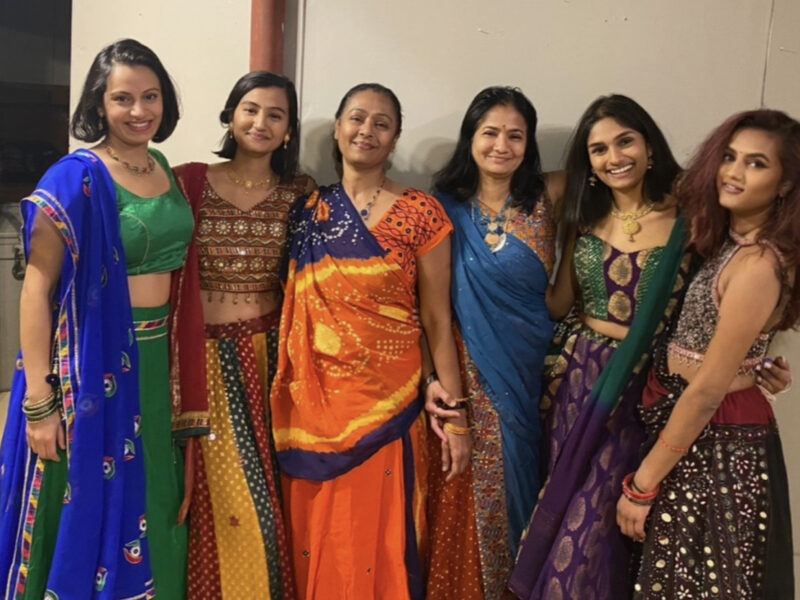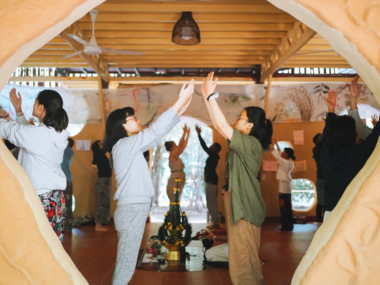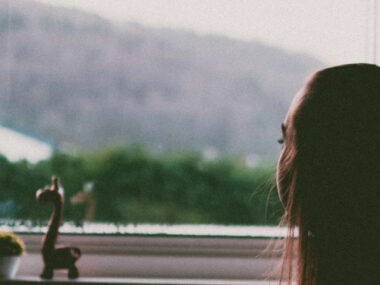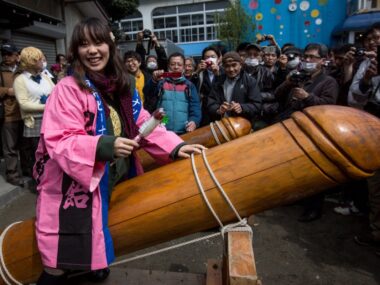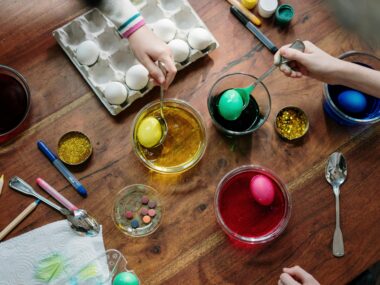Table of Contents
As someone who grew up around my mom’s Gujarati side of the family, some of my fondest memories are tied to Navratri. I can still picture the chaos of getting ready with my cousins, crammed into the bathroom, slipping into our shimmery chaniya cholis, and grabbing our dandiyas before heading out the door.
Those nights of dancing together, surrounded by folk music, color, and energy, were honestly some of the best parts of being Gujarati. Looking back, I didn’t realize how important those moments were for bonding with my culture. We call it Garba, and to me it has always been one of the most magical experiences that brings people together. Growing up in Toronto, finding that connection to my Gujarati roots wasn’t always easy. Garba wasn’t just something we did once a year, it became a tradition that shaped both my childhood and my adulthood.
What is Garba?
If you have never been to one, the easiest way to describe Garba is that it is a traditional Gujarati dance where you’re surrounded by 500 other people dancing in large circles. It’s definitely a sight to see. But honestly, calling it just a dance feels too small for what it actually is.
Garba is a full blown experience, not only is it a celebration, but in many ways also a prayer and devotion. Mix music, movement and spirituality into a big pot and there you have it, Garba.
Now let’s talk about Navratri. This is when Garba is celebrated or performed. Navratri, which literally translates to “nine nights,” is when people come together to celebrate Goddess Durga and her many forms (ANU South Asia Research Institute) The dancing, the music and all the attire basically revolve around worshipping and honouring her. Garba is traditionally a devotional practice, but it also brings with it a sense of community. It’s a form of prayer, but it is also fun and lively. That combination is what makes it so special.
Many people outside the community confuse Garba with Dandiya, but they are not the same. Garba uses claps and circular steps, while Dandiya Raas involves pairs striking sticks in rhythm (Art of Living). Most Navratri nights begin with Garba and then shift into Dandiya as the energy rises, and honestly, it’s not a full garba night unless you’ve done both.
One of the best things about the dancing itself is that it’s quick to learn and easy to join. The steps are pretty easy and repetitive, so even if you don’t know what’s going on, it’s okay. All you have to do is step into the circle, watch the person ahead of you, and find the beat. Within minutes, you feel like you belong.
The Cultural and Spiritual Roots
One thing about Garba is that it isn’t just dancing for the sake of dancing. That spiritual connection that a lot of people have to it makes it feel bigger than just a night of fun. The word “garba” itself takes its roots from the word “garbha,” meaning womb. Which is why, in traditional Garba, people dance in circles around a clay pot with a lamp inside, called a garbha deep. This lamp is supposed to represent life and the goddess’s energy right in the middle of it all (Art Idea). Although it is not commonly done in this way today, it is still practiced in some parts of India.
Even the circle itself has meaning. It shows how life is a cycle that keeps going. From birth, life, death, rebirth, all while the light in the center stays steady. You might not think about all that when you are dancing, but when you are in the circle, moving in rhythm with everyone else, it really does feel powerful.
There are other little traditions too, like dancing barefoot. It is not just because shoes are uncomfortable, it is actually about showing respect to the earth and feeling more connected to the energy of the ground while you dance (Homegrown).
To me, this mix of devotion and fun is what makes Garba so special. You are praying, celebrating, and having fun all at the same time.
The Experience of Garba Nights
If you have ever been to a Garba night, you probably know exactly what the first few moments feel like. First, it’s the loud music. The beat of the dhol, the singing, and the claps in unison. Then you look around and there are the colors. Everywhere you look, people are in bright chaniya cholis, heavy mirror work jewelry, embroidered kediyus, and phento headwear for the guys.
As a kid, I remember walking into a huge hall filled with hundreds of people. At first it was overwhelming. I remember telling my parents I didn’t like the fact that there were so many people there and wanted to just go home. But the moment I was pulled into a circle and started getting into the groove of everything, that feeling changed…drastically. Dancing with my cousins and family felt natural, like I was meant to be there.
If nights like this make you crave more connection to culture and community, join our Uncharted community and explore stories that celebrate both.
Garba is just one of those things where if you were to look at it from a bird’s eye view, you’d be so shocked to see everyone just flowing together in circles, it’s like how you would look at a whirlpool in the ocean. Everyone is flowing to the beat. Even if you don’t know the steps, you just jump in and follow along. There is no judgment, only laughing, clapping, and spinning. It is fast-paced, but once you catch the rhythm and flow with the crowd, it is one of the best feelings in the world.
What makes Garba special is how the energy builds. At the beginning, the steps are slower and more simple. By the middle of the night, the music gets faster and everyone is moving quicker, cheering each other on. As time goes on the circle gets bigger, more circles form in between, the claps get louder, and suddenly you are sweating, and completely taken away by the music.
And then there are the little things that make it unforgettable. The aunties passing around snacks like kichu during breaks, which was always my favorite part. The uncles clapping slightly off-beat but still bringing all the vibes. The older cousins in the family taking the younger ones aside to teach them the steps. For me, all those little details are just as much a part of Garba as the dancing itself.
Fashion and Tradition
Getting ready for Garba is honestly half the fun. We’d get together hours before we’d have to leave and start preparing ourselves. For us girls, it usually involves putting on a chaniya choli, which is a long skirt with a matching blouse and dupatta. The outfits have so much personality, full of bright colors, heavy embroidery, and mirrors that catch the light when you spin. Add on stacks of bangles, jhumkas, bindis, and sometimes even a nose ring, and there you have it, the perfect fit for a perfect night.
As a kid, I loved watching my cousins and I transform into these little Indian princesses that made us feel so connected to our culture. As we got older, every year we would switch outfits and rewear each other’s chaniya cholis, and we did this for over ten years. It was so much fun, and honestly made getting ready just as special as the actual dancing.
Men’s Garba attire featuring a kediyu, churidar pants and embroidery
For the guys, the traditional outfit is called a kediyu, which is a short, flared top paired with churidar pants. The embroidery and mirror work are just as detailed as the women’s outfits, and a phento (the headscarf or band tied around the head) completes the look. Even though some guys will just show up in jeans and a kurta, there is something about seeing everyone in traditional clothes that makes the whole night feel even more festive. Trust me, when you see someone in a super traditional outfit, you know they’re about to tear up the dance floor.
The best part is how no two outfits are ever the same. Everyone has their own style. Some people go classic and stick to traditional patterns, while others mix it up with modern cuts or fusion outfits. As I got a bit older, I started seeing (and wearing) sequins, neons, and even Western blends. But whether simple or dramatic, the outfits always bring so much personality to the dance floor.
And let’s be real, getting ready together is a big part of the memory. I still think about trading jewelry with my cousins, getting my aunt to pin up all of our dupattas, and hyping each other up. The night starts right there in the room with your loved ones getting ready, before you even head out the door.
The Music and Dance Styles
The music is really what makes or breaks Garba in my opinion. Most nights start with traditional folk songs in Gujarati that honor Goddess Durga. There’s actually one point in the beginning where we sit down and do a prayer together. When that’s all done, you start to hear the beat of the dhol and nagada (kettle drum), the sound of the harmonium, and then the clapping begins.
One of the most classic moves of Garba is called teen taali, which literally means three claps. It goes clap, clap, clap, then step and turn. It is simple and is the foundation for so many Garba songs. Once you figure it out, you can basically say you know how to do Garba.
And of course, you cannot talk about Garba music without mentioning Atul Purohit. He is one of the most famous Garba singers, also known as king of traditional Garba. Ask any Gujarati person who he is and they’ll likely know. His voice is instantly recognizable, and for decades he has been leading massive crowds, especially at the United Way Garba in Vadodara, which is one of the biggest Garba events in the world. Even now, he travels to Canada (where I’ve seen him), the US, and the UK during Navratri so the diaspora can experience that same energy. For many Gujaratis, hearing Atul Purohit sing “Tara Vina Shyam” or “Maniyaro” feels like the real start of Navratri.
Over the years, the music has also changed. Many events still keep it traditional, but now you also hear Bollywood remixes and even DJs mixing beats into Garba songs. It brings together different generations. The older crowd gets their traditional songs, and the younger crowd gets the modern versions they love. It is all part of keeping Garba alive and exciting.
No matter what the playlist is, the music is the heartbeat of Garba. It builds slowly, picks up speed, and by the end of the night you are clapping, spinning, and moving so fast that you forget how tired you are. Somehow, you’re still excited to come back again next year. That is the moment when you realize why people keep coming back.
Garba Beyond Gujarat
One of the coolest things about Garba is how it is not just limited to Gujarat anymore. Wherever Gujaratis go, Garba goes with them. That is why today you can find huge Navratri events happening not only in India but also in places like Canada, the US, the UK, Australia, and even parts of Africa. It has really become a global tradition that brings the community together no matter where we are.
Growing up in Canada, I saw this first-hand. Every year, local community centers and mandirs would organize Garba nights. Families would show up in their best outfits, food stalls would be set up with things like samosas and jalebis, and the halls would be packed.
In North America, some of the biggest Garbas are massive productions. In places like Toronto, New Jersey, and Houston, thousands of people gather to dance to both traditional singers and new-age DJs. Atul Purohit himself tours internationally during Navratri, and his shows are always sold out because hearing him live makes people feel like they are back home in Vadodara (Sulekha Events).
What I love most about Garba outside India is that it creates a space for the younger generation to connect with their culture. When you grow up in the diaspora, it is easy to feel disconnected, but Garba nights give you that sense of belonging. You see people your age who might not speak Gujarati fluently or who might be more used to jeans than chaniya cholis, but for those nights, everyone comes together. The music, the food, the clothes, the energy, it all bridges that gap.
Garba has also become a way to share Gujarati culture with others. In Canada, I have seen non-Gujarati friends come to Garba, try the steps, and fall in love with it. It is one of those traditions that is so welcoming and joyful that you don’t have to be part of the community to enjoy it. That openness is probably one of the reasons why Garba has grown so much outside Gujarat. No gatekeeping here. It’s something everyone can be part of.
What Garba Means Today
Growing up, I didn’t always know that Garba was so closely tied to religion and culture. Learning the depths of what the celebration truly means has allowed me to connect even more with the Gujarati community and my own identity. Now, when I walk into a space filled with people dancing together, I can truly embrace the beauty of it all, something that’s shared with so many other people around the globe.
It’s so fascinating because it bridges generations. I’ve seen my grandparents, parents, and cousins all dancing in the same circle. Some move faster than others, but for those few hours, age doesn’t even matter. We all share the same music, the same steps, and the same energy. That is rare, and it is something that we may not be able to experience with loved ones forever.
On a personal level, Garba is a reminder of who I am and where I come from. Even growing up in Canada, it gave me a way to connect back to Gujarat. It showed me what my aunts and grandparents did every year and reminded me of the home that although I didn’t live in, is where my roots will always be. That is why Garba still matters to me today. It reminds me why this tradition will always be a part of who I am.
If this piece spoke to you, check out my Diwali story next! A celebration of light, family, and everything that feels like home.
Why does Garba still matter to younger generations?
Because it gives them a sense of belonging. Even outside India, Garba connects people to their heritage through music, movement, and shared joy. It keeps culture alive in a fun, welcoming way.
How has Garba changed outside India?
In cities like Toronto, New York, and London, Garba has evolved with fusion music, modern outfits, and massive multicultural events. It’s now as much about identity as celebration.
Why is Garba considered more than a dance?
Because it combines devotion, art, and community. Each circle symbolizes life and unity, turning the act of dancing into a moving form of prayer and connection.
How does Garba bring people together?
It breaks barriers instantly. Whether you know the steps or not, once you join the circle, everyone moves in rhythm. It’s one of the rare traditions where joy is the only requirement.
What does Garba represent in the Gujarati diaspora?
For many Gujaratis abroad, Garba is a bridge to home. It’s a night where families, friends, and even strangers share laughter, rhythm, and the comfort of belonging.
Can non-Gujaratis participate in Garba?
Absolutely. Garba is open to everyone. You don’t need to know the language or the steps, just the willingness to join, smile, and move with the beat.

